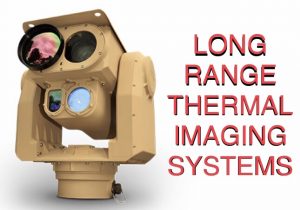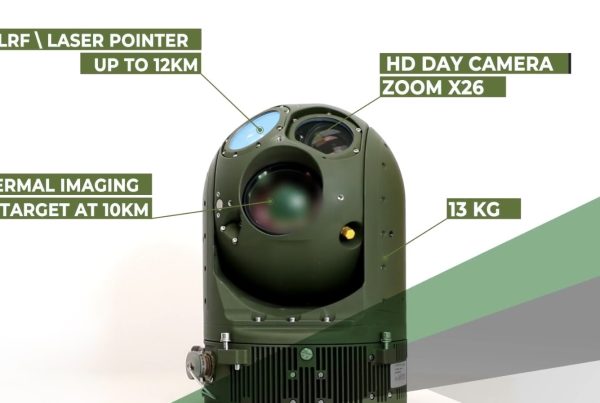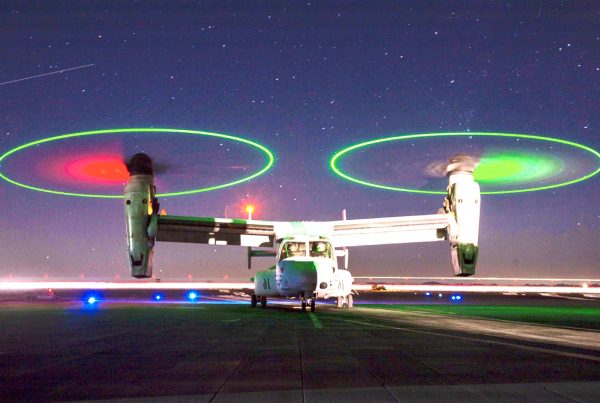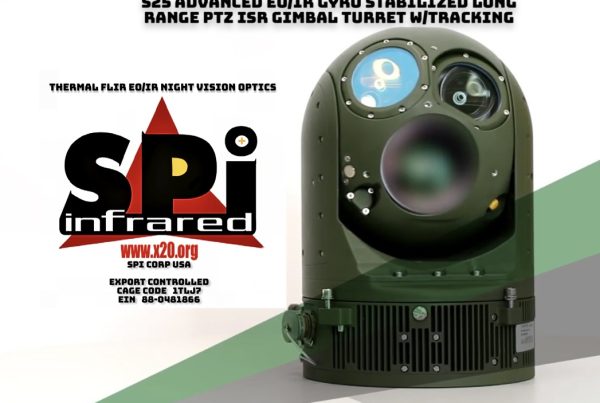Long range PTZ flir thermal
imaging camera resources
Long range PTZ (Pan Tilt Zoom) FLIR (Forward Looking InfraRed) are steerable thermal imaging video camera systems that are typically coupled with a daytime low light zoom camera (Multi Sensor) or (Dual Sensor).
These systems are packaged in a heavy duty gimbal positioner that Pans and Tilts the camera system to predetermined locations or are directed by a user moving the cameras with a joystick, keyboard or a computer system. These devices are built to withstand harsh environments typically in borders, shorelines, airports and other critical areas that require day and night security and surveillance in both The day and night. Long range thermal imaging cameras are heat sensing video cameras that can detect human or vehicle activity In low light or no light scenarios.
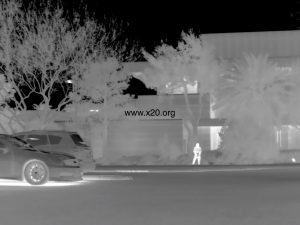
The long range thermal imaging PTZ flir cameras are sometimes integrated with LRF Laser rangefinders which display distance read outs of targets as well as IR Lasers pointers and illuminators for pointing out targets of interest or are used to illuminate very dark areas. Additional cameras such as SWIR (Short Wave Infrared) can be integrated as well as laser range finders LRF, Laser pointers and illuminators. A long range PTZ thermal or thermographic flir imaging camera collects electromagnetic radiation which is formed into an image. But while a conventional cmos/ccd, tv, eo or ccd/cctv cameras works in the range of visible light, i.e. with wavelengths between approximately 400 and 700 nanometers (0.4–0.7 μm), a thermal imaging flir camera is designed to detect radiation with greater wavelengths, up to around 14,000 nanometers (14 μm). Radiation in this part of the electromagnetic spectrum is referred to as infrared, or commonly IR, which in turn can be divided into several sub-groups. Near-infrared light has a wavelength of about 0.7–1.5 µm, which is just beyond what the human eye can see. Camera sensors, on the other hand, can be built to detect and make use of this type of radiation. A so-called day-and-night camera uses an IR-cut filter during daytime to filter out IR-light so it will not distort the colors of images as perceived by the human eye. When the camera is in night mode, the IR-cut filter is removed. Since the human eye is unable to see infrared light the camera displays the image in black and white. Near infrared light or NIR also requires some kind of light source – either natural, such as moonlight, or man-made, such as street lights or a dedicated IR-lamp.
Standard SD and HD Functionality from the Long range M7 IR PTZ Provides an optioanl 16:9 wide screen video that shows more of the important part of the scene and fits well on modern screens. The long range M7 thermal imaging camera is equipped with powerful continuous optical zoom capability on the thermal image. It offers excellent situational awareness but also the possibility to zoom-in, and see more detail, once a target has been detected. This way operators can see farther recognize more detail and react more quickly to security threats. The advantage of continuously zooming compared to other systems that are using a rotating lens system is that there is no switch or swapping between the different images. You can gradually zoom in while keeping your focus all the time. The unit has quick auto focus & has a plethora of upgradeability options to make sure the system stays current with your evolving surveillance network.
Moving further away from visible light, the rest of the IR-spectrum is usually divided into the following categories: Short-Wave Infrared (SWIR), approx. 1 – 3 µm Mid-Wave Infrared (MWIR), approx. 3 – 5 µm Long-Wave Infrared (LWIR), approx. 8 – 12 µm Very Long-Wave Infrared (VLWIR), approx. 12 – 25 µm Far-Wave Infrared (FWIR), approx. 25 µm – 1 000 µm or 1 mm Note that there is a gap between 5 µm (MWIR) and 8 µm (LWIR). This part of the waveband is virtually unusable for thermal imaging purposes because of the high spectral absorption of the atmosphere in this range. Microwaves have a wavelength exceeding 1 mm. At the far end of the spectrum are radio waves, with a wavelength of 1 meter and more. In the other end of the spectrum, wavelengths shorter than those of visible light are successively referred to as ultraviolet, x-rays, and gamma rays.
An object’s thermal radiation is also dependent on its temperature – the hotter it is the more thermal radiation it emits. Humans cannot see this, but we can sense it, for example, when we approach a camp fire or enter a sauna. The greater the temperature difference in a scene, the clearer will the thermal flir images will be. Furthermore, some materials will have a different emissivity in the mid-wave infrared spectrum than in the long-wave span. For imaging purposes these differences in emissivity are, for the most part, of secondary importance since the camera’s sensitivity can be defined as its capability to distinguish between temperature differentials. Thermal images are sometimes associated with bright, intense colors – which may seem a bit odd considering that the camera works outside the spectrum of visible light. The answer is that the colors are created digitally, so-called pseudo-colors but produce a very vivid crisp useable picture. Each color or nuance represents a different temperature, usually white and red for higher temperatures, over green, blue and violet for colder ones. The reason is foremost practical since the human eye is better at distinguishing different shades of color than different shades of grey. Detectors used for thermal imaging can be broadly divided into two types: Cooled thermal imagers that typically operate in the mid-wave infrared (Long range MWIR) band and uncooled thermal imagers that operate in the long-wave infrared (long range LWIR) band. Ultra Extreme long range Cooled and uncooled systems both have thier advantages in the world of distant range narrow FOV thermal imaging applications.
With PTZ or pan / tilt / zoom thermal imaging becoming relatively cheaper and an integral part of Short, medium, long and extreme ultra long range Surveillance, security, observation systems, a whole range of uses becomes both possible and economically viable. long range Thermal flir PTZ cameras can be an excellent complement in many situations where conventional cameras diminish thier performance as low light levels are present. They are, of course, unparalleled in a situation of twilight, thermal cross-over, near darkness and total darkness. They can also be an option in areas that are very difficult to illuminate effectively, for example a sea front, a harbor, or any other vast expanse of open water thus making SPI’s long range PTZ thermal infrared imaging Ir cameras paramount for use in marine, boat, vessel and ship applications. Similarly, artificial light not only runs the risk of revealing where the cameras are placed, enabling parties to avoid or vandalize them, but can also create projected shadows in which an intruder can avoid detection. Furthermore, spotlights can blind as well as illuminate. So cameras that do not rely on light can be the preferred solution in many different traffic situations, whether it is in railway tunnels, on air strips, runways, or on regular streets. Long Range Thermal flir PTZ cameras, on the other hand, cannot be blinded by bright lights or laser beams.
SPI Corp’s long range multi sensor Eoir flir thermal imaging camera systems offer substantial long distance detection ranges allowing the operator to be positioned at very far distant standoff locations offering ample time to react, to threats or targets of interest. Long range imaging systems provide a benefit to the user when coupled with an array of sensors and geo locating modules especially in specialty military, security and surveillance applications. The farther you are, the more time you have to react and not be seen.
What the science behind a long range thermal imaging FLIR IR night vision PTZ pan tilt gimbal turret camera?
(a) Housing – Usually composed of an aluminum bell shaped cover, The housing can be of all shapes and sizes from plastic to military grade hardened coated all weather NBC Nuclear Biological Chemical compliant
(b) Camera module
This is where the image FLIR, MWIR, LWIR, SWIR, night vision, intensified, cmos, long wave, short wave, mid wave cooled and uncooled detector and sensors reside, CCD sensor, optical zoom germanium DFOV, TFOV, Fixed and CZ continuous zoom lenses, and the motors that control Zoom and Focus are located.
(c) PTZ Pan Tilt control board
The PTZ control board processes RS485 data that converts it into mechanical movements. Some are Pelco, Pelco Extended and are available in a wide array of protocols supporting VMS, GUI, ONVIF, IP, ETHERNET, FIBER, MICROWAVE, ANALOG, DIGITAL and WIRELESS
(d) PTZ motors – are the small motors that allow the thermal FLIR and CCTV HD camera to perform up, down, left and right functions. Marked by the arrows are two step motors; the one to the top controls up and down movements and the one at the bottom controls left and right movements, some systems have no motors and other methods of moving the cameras PTZ, some use brushless motors.
We can Customize your long range Pan Tilt Zoom Thermal, CCTV and other exotic sensor system to cater to your exact application,
We have facilities that can satisfy any requirement in a rapid response timeframe. We offer the worlds longest range, best weapons grade all weather IP68 hardened PTZ EOIR
imaging systems.
Long Range Visible HD CCTV cameras can compliment the Thermal cameras and assist in daytime and low light DRI (Detection, Recognition and Identification)
Long range Critical infrastructure applications require not only continuous video surveillance and monitoring, but also a solution that yields highly reliable intrusion detection, with fewer false alarms. This need makes advanced video analytics a must for any adequate long range thermal/cctv surveillance system.
Advanced analytics will provide multiple automated alarm notification options, including email, edge image storage, digital outputs or video management software (VMS) alarms. Incorporating high quality, unique and adaptive analytics can virtually eliminate false alarms, allowing security personnel to respond more efficiently and effectively, while also lowering overall cost for the end user.
While traditional long range surveillance & security technologies such as radar, thermal flir imaging and visible cameras, or video analytics work well on their own, utilizing all of these options together provide an advanced perimeter detection system. For example, ground surveillance radar can detect possible threats beyond the fence line as they approach and send a signal to pan-tilt-zoom (PTZ) cameras, triggering them to slew to a specific location. From there, embedded analytics and visible cameras can further identify objects, notify authorized staff, and collect additional evidence through facial recognition or high-quality photos.
Once a long range intrusion attempt is discovered, it is important to act fast. Organizing a response system that can initiate actions based on GPS location data, such as the slewing of FLIR PTZ cameras, automated intruder tracking or activated lighting sensors, greatly increases staff’s situational awareness while easing their workload. For instance, thermal imagers deployed in conjunction with video analytics can be used to generate an initial alarm event, which can then trigger a sequence of other security equipment and notifications for personnel to eventually respond to. Having all of this in place essentially lays the entire situation out in a way that allows responders to accurately understand and evaluate a scene.
After the designated auto-response mechanisms have activated and done their job, it is time for responders to acknowledge and assess the situation. From here, authorized personnel can take the next appropriate step toward defending against and delaying the threat. Deterring suspicious activity can be achieved through real-time two-way audio, a simple but powerful tool. Often, control room operators can diffuse a situation by speaking over an intercom, telling the trespasser that they are being watched and that the authorities have been notified.
The primary purpose of the delay facet of the overall perimeter protection strategy is to stall an attempted intrusion long enough for responders to act. Access control systems play a key role in realizing this objective. When a security officer sees a non-compliant, suspicious individual on the camera feed, the officer can lock all possible exits to trap them in one area all through the VMS.
Long Range PTZ Thermal imaging flir camera applications;
Military combat surveillance applications
FOB perimeter/critical facility infrastructure, high value security
Border / coastline / scope truck / homeland security / AWD / 4×4 / All Terrain /frontier patrol & security
Security and surveillance
Fully Integrated Sensor Suite
Tactical Combat armored vehicle
Law Enforcement
Drone/UAV/UAS/SUAS Detection
IED Detection
Critical facility security (power stations, prisons, government offices)
Mobile, mast or tripod mounted for sea & land monitoring
Vehicle safety applications (railways, mines, heavy equipment)
Cruise ship man overboard detection & rescue
Land & sea security, search & rescue operations
Border//Frontier/Shoreline/Coast/Runway/Airstrip/Tripod/Radar Applicable
Laser IR Diode illuminators available in a variety of ranges from short/medium, long and ultra extreme long range
Military/Law Enforcement/Search and Rescue/Coastal/Frontier/Border + DEA & SWAT applications
Windows or MAC software compatibility
Remote operation with Ethernet, ip, fiber, solar, wireless, microwave gps and compass radar compatible slew to cue, slew to alert and alarm detection
Software development kit (SDK) for customized functionality / command and control

